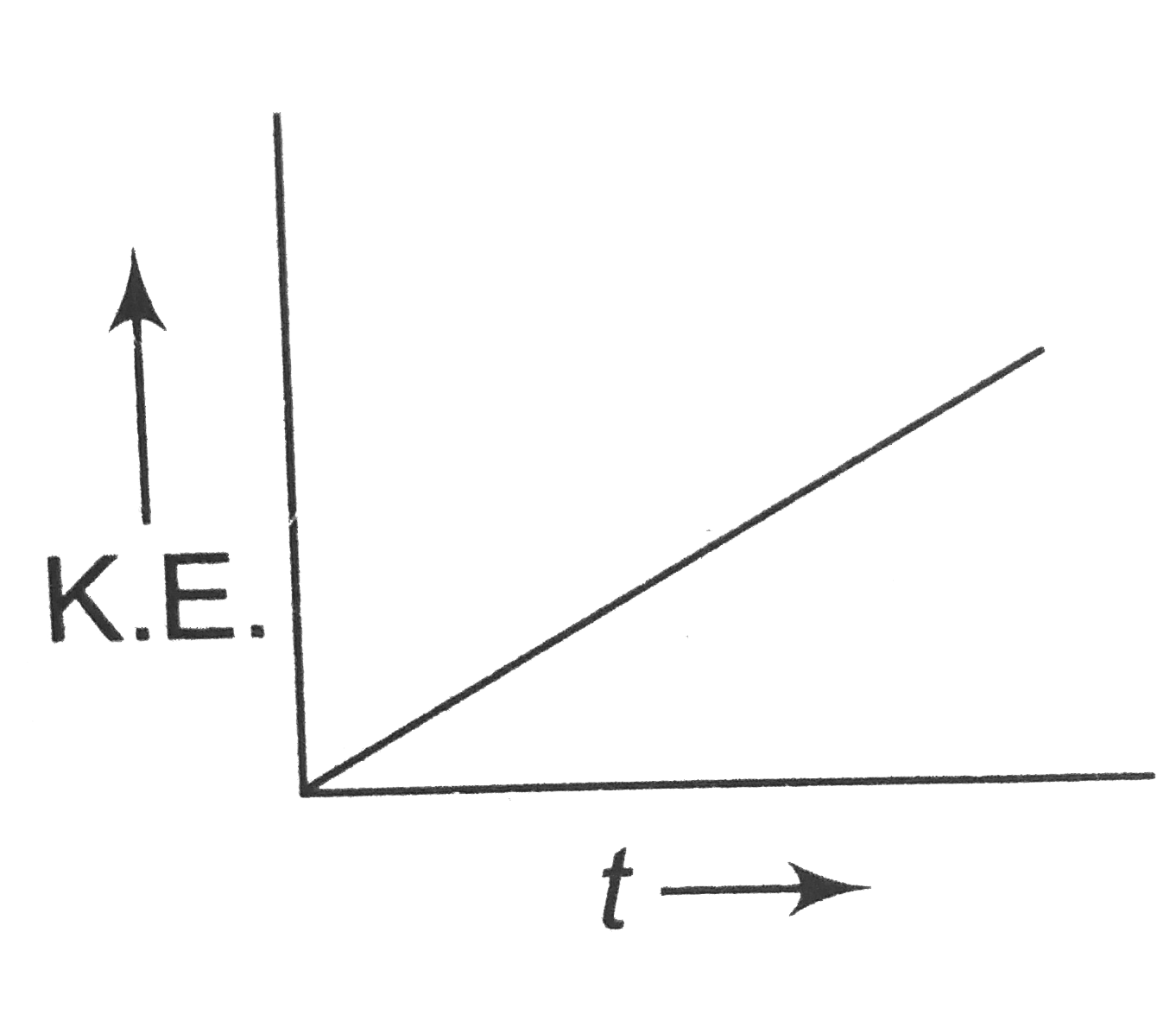If the kinetic energy of a body is directly proportional to time t, the magnitude of the force acting on the body is
directly proportional to √t
inversely proportional to √t
directly proportional to the speed of the body
inversely proportional to the speed of the body
The correct Answer is:B, D
To solve the problem step by step, we will analyze the relationship between kinetic energy, velocity, acceleration, and force.
Step 1: Establish the relationship between kinetic energy and time
Given that the kinetic energy K of a body is directly proportional to time t, we can express this mathematically as:
K=C⋅t
where C is a constant.
Step 2: Relate kinetic energy to velocity
The kinetic energy of a body is also given by the formula:
K=12mv2
where m is the mass of the body and v is its velocity. Setting the two expressions for kinetic energy equal to each other, we have:
12mv2=C⋅t
Step 3: Solve for velocity
Rearranging the equation to solve for v2:
v2=2C⋅tm
Taking the square root of both sides gives us the velocity v:
v=√2C⋅tm
Step 4: Find acceleration
Acceleration a is defined as the rate of change of velocity with respect to time. Therefore, we differentiate v with respect to t:
a=dvdt
Using the expression for v:
v=√2Cm⋅t1/2
Differentiating this with respect to t:
a=√2Cm⋅12t−1/2
This simplifies to:
a=√2C2√m⋅1√t
Step 5: Relate force to mass and acceleration
According to Newton's second law, the force F acting on the body is given by:
F=m⋅a
Substituting the expression for acceleration:
F=m⋅√2C2√m⋅1√t
This simplifies to:
F=√2Cm2√t
Step 6: Determine the relationship between force and time
From the expression for force, we can see that:
F∝1√t
This indicates that the force is inversely proportional to the square root of time.
Conclusion
Thus, the magnitude of the force acting on the body is inversely proportional to the square root of time.
Given that the kinetic energy K of a body is directly proportional to time t, we can express this mathematically as:
K=C⋅t
where C is a constant.
The kinetic energy of a body is also given by the formula:
K=12mv2
where m is the mass of the body and v is its velocity. Setting the two expressions for kinetic energy equal to each other, we have:
12mv2=C⋅t
Rearranging the equation to solve for v2:
v2=2C⋅tm
Taking the square root of both sides gives us the velocity v:
v=√2C⋅tm
Acceleration a is defined as the rate of change of velocity with respect to time. Therefore, we differentiate v with respect to t:
a=dvdt
Using the expression for v:
v=√2Cm⋅t1/2
Differentiating this with respect to t:
a=√2Cm⋅12t−1/2
This simplifies to:
a=√2C2√m⋅1√t
According to Newton's second law, the force F acting on the body is given by:
F=m⋅a
Substituting the expression for acceleration:
F=m⋅√2C2√m⋅1√t
This simplifies to:
F=√2Cm2√t
From the expression for force, we can see that:
F∝1√t
This indicates that the force is inversely proportional to the square root of time.
Thus, the magnitude of the force acting on the body is inversely proportional to the square root of time.
Topper's Solved these Questions
- WORK, POWER AND ENERGYBOOK - DC PANDEY ENGLISHCHAPTER - WORK, POWER AND ENERGYEXERCISE - C Comprehension Type Questions
18 Videos
- WORK, POWER AND ENERGYBOOK - DC PANDEY ENGLISHCHAPTER - WORK, POWER AND ENERGYEXERCISE - D Matrix Matching Type Questions
10 Videos
- WORK, POWER AND ENERGYBOOK - DC PANDEY ENGLISHCHAPTER - WORK, POWER AND ENERGYEXERCISE - A Only One Option is Correct
42 Videos
- WORK, ENERGY AND POWERBOOK - DC PANDEY ENGLISHCHAPTER - WORK, ENERGY AND POWEREXERCISE - MEDICAL ENTRACES GALLERY
33 Videos
Similar Questions
Knowledge Check
Kinetic energy of a body is independent of ………..
Aforce appliedBtime for which force is appliedCelasticity of the bodyDnone of the aboveIf the force acting on a body is inversely proportional to its speed, then its kinetic energy is
Alinearly related to timeBinversely proportional to timeCinversely proportional to the square of timeDa constant
The energy radiated by a black body is directly proportional to :
View SolutionKinetic energy of a particle moving in a straight line is proportional to the time t. The magnitude of the force acting on the particle is :
View SolutionThe kinetic energy of a molecule of a gas is directly proportional to the absolute temperature of the gas.
View SolutionIf the force acting on a body is inversely proportional to its speed, the kinetic energy of the body is
View SolutionThe distance covered by a moving body is directly proportional to the square to the time. The acceleration of the body is
View SolutionThe kinetic energy of a body moving along a straight line varies with time as shown in figure. The force acting on the body:

View Solution
